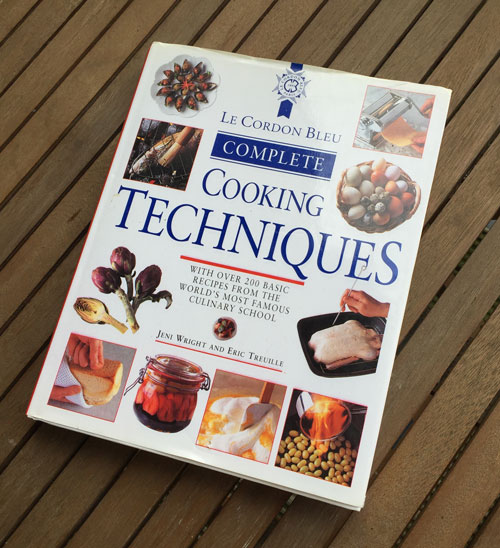Le Cordon Bleu’s Complete Cooking Techniques
I was recommended Le Cordon Bleu’s Complete Cooking Techniques who said it was more than just a cookery book: it really took the time to explain the techniques used in cooking. It is available new for around £65, but it you are happy with a used copy you can pick it up a hardback copy for £0.01. There is £2.80 shipping on that, but still a bargain.
It is a comprehensive book. There are five full pages discussing the different equipment you may find in a kitchen and what they are all used for. Each section (fish, beef, cheese, vegetables, etc) has a full spread on what to look for when buying them. It takes you step by step through cleaning fish, which colour photographs to illustrate each stage. The margins contain suggestions containing extra tips for doing it like the pros, examples of cuisines that use the technique and histories of the foods.
There are very few recipes in the book. In the chicken section for example, it shows you how to prepare a bird for roasting, jointing and cutting the pieces, and different methods for cooking chicken. It is up to you what you do with those techniques. There are some recipes in there, but they feel more like they are there for illustrations, and perhaps a little out of place. Some of the techniques are recipes in themselves: making a terrine for example is pretty much the whole process of terrine-based dinner.
I like the attention to detail the book brings. It has a “finishing touches” spread in which it talks about the garnishes of herbs and decorations you can add to a dish to finish it off. It also contains a host of useful tables: approximate cooking times, what cut suits each cooking method, what herbs to use with what dish.
The downside is two-fold. First, I already knew a lot of the stuff in the book. Not because I had ever read it but because you pick it up as you go along. I am interested to know why you should add herbs at the very end (heat destroys their delicate flavour) but after 100 recipes telling me to add the coriander just before serving, you pick that stuff up anyway.
Second, there is very little actionable stuff in the book. I feel I know a little more about cooking, including why I am doing things, but I don’t know what I will do now to put these ideas into practice to reinforce the knowledge.

I was recommended Le Cordon Bleu’s Complete Cooking Techniques who said it was more than just a cookery book: it really took the time to explain the techniques used in cooking. It is available new for around £65, but it you are happy with a used copy you can pick it up a hardback copy for £0.01. There is £2.80 shipping on that, but still a bargain.
It is a comprehensive book. There are five full pages discussing the different equipment you may find in a kitchen and what they are all used for. Each section (fish, beef, cheese, vegetables, etc) has a full spread on what to look for when buying them. It takes you step by step through cleaning fish, which colour photographs to illustrate each stage. The margins contain suggestions containing extra tips for doing it like the pros, examples of cuisines that use the technique and histories of the foods.
There are very few recipes in the book. In the chicken section for example, it shows you how to prepare a bird for roasting, jointing and cutting the pieces, and different methods for cooking chicken. It is up to you what you do with those techniques. There are some recipes in there, but they feel more like they are there for illustrations, and perhaps a little out of place. Some of the techniques are recipes in themselves: making a terrine for example is pretty much the whole process of terrine-based dinner.
I like the attention to detail the book brings. It has a “finishing touches” spread in which it talks about the garnishes of herbs and decorations you can add to a dish to finish it off. It also contains a host of useful tables: approximate cooking times, what cut suits each cooking method, what herbs to use with what dish.
The downside is two-fold. First, I already knew a lot of the stuff in the book. Not because I had ever read it but because you pick it up as you go along. I am interested to know why you should add herbs at the very end (heat destroys their delicate flavour) but after 100 recipes telling me to add the coriander just before serving, you pick that stuff up anyway.
Second, there is very little actionable stuff in the book. I feel I know a little more about cooking, including why I am doing things, but I don’t know what I will do now to put these ideas into practice to reinforce the knowledge.
